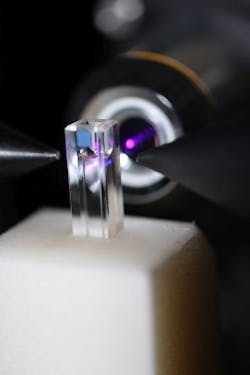Fluorescence method can detect tumor markers easily
It is time-consuming and expensive to identify specialized tumor markers that indicate the presence of cancer, even though blood is teeming with proteins. Realizing this, researchers in the Project Group for Automation in Medicine and Biotechnology (PAMB) of the Fraunhofer Institute for Manufacturing Engineering and Automation (IPA; Mannheim, Germany) have developed a new fluorescence method that enables cancer diagnosis to be carried out in a single step.
Related: 'Smart beacons' target cancer tumors
Related: Fluorescence microscopy aids in melanoma development discovery
Tumor markers in the blood help determine whether the patient is afflicted with a malignant tumor and whether it is excreting markers more vigorously—involving highly specific proteins. An increased concentration in the blood provides one indication of the disease for physicians, but it is expensive and time-consuming to detect the markers due to the large amount of molecules and proteins present in blood. To be able to detect a single, specific protein, doctors must first separate and purify the blood in several steps, and then isolate the marker they are searching for from the rest of the molecules.
To that end, the researchers developed a one-step fluorescence analysis method that improves signal-to-noise ratio in recognizing individual molecules in blood samples, says Caroline Siegert, a scientist at IPA. First, they used magnetic beads (particles measuring a few micrometers in size with a magnetic core) that, when positioned using an external magnet on the test tube, can be halted or steered. To isolate molecules from blood (or other biological samples), the researchers coated the surface of the beads with specialized antibodies. If the proteins that are being searched for meander past the beads, the antibodies grab hold of them. By holding a magnet to the outside of the test tube, the beads—together with the desired proteins—stick to the interior surface of the tube, while the rest of the solution can be easily removed. Also, the samples and investigation are not just exposed to the coated beads, but also to additional antibodies that have fluorescent markers bound to them. These antibodies attach themselves to the proteins being searched for and cause them to glow. The optical signal is very weak, though, and would normally disappear in the background noise. By applying an alternating magnetic field, the magnetic beads flock together in rhythm and the fluorescent markers bound to the surfaces emit their light in sync—and radiate considerably more brightly than any given bead by itself. The advantage of this visualization method is that the optical signal provides immediate insight about whether a tumor marker protein is present in the blood.
The new method not only detects numerous biological molecules such as antibodies, but also nucleic acids that indicate an infection. “Since we use conventional beads, it means the molecules can be quickly and simply isolated after the analysis as well,” Siegart says.
The researchers will present results using their method at the Analytica international trade fair, to be held April 1-4, 2014, in Munich, Germany (Hall A1, Booth 530).
-----
Follow us on Twitter, 'like' us on Facebook, and join our group on LinkedIn
Subscribe now to BioOptics World magazine; it's free!

